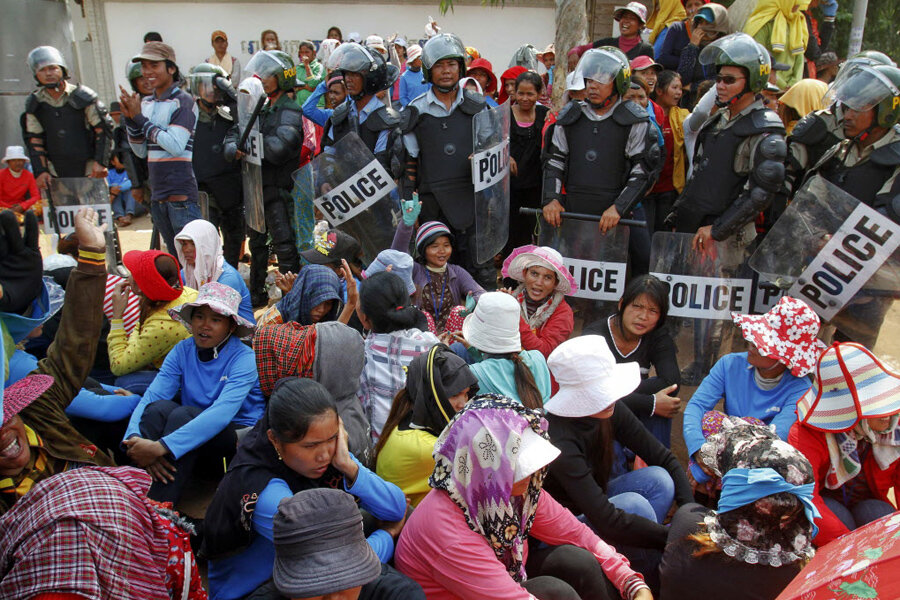Some 300 Cambodian Nike workers fired after protests
Loading...
Cambodia's garment industry is increasingly considered the moral alternative to that of scandal-ridden Bangladesh. But this week a Nike clothing factory there fired some 300 workers after they protested for weeks about low wages.
Cambodia’s garment industry represents almost 80 percent of its exports, and with more than 300 factories and about 350,000 employees it is the booming heart of Cambodian economic life. For that reason, the government has aggressively polished the industry’s image over the past decade to reel in foreign retailers. But analysts say that much of the touted reforms are just gloss, lacquered onto a reality rife with abuses.
“It’s part of its marketing strategy,” says Kimberly Elliott, a senior fellow at The Center for Global Development. “The idea is to give buyers some assurance that they won’t face a sweatshop scandal.”
In May, about 4,000 Cambodian laborers stood outside a Nike clothing factory in Kampong Speu Province, just outside the urban capital, Phnom Penh. Earning a monthly wage of $74, the workers wanted an additional $14 a month to help pay the costs of transportation, rent, and health care. They would not go back to work without it.
Factory owners fired some 300 employees, claiming they didn’t follow labor union rules of protest.
The mass firing comes on the heels of heightened international attention on the working conditions in the garment industry. Last month a Bangladeshi garment complex collapsed, killing more than 1,000 workers in the largest garment industry accident in recent history.
That accident brought Cambodia’s industry – billed as a still cheap but more ethically sound place to do business – into focus. In 1999, as part of the US-Cambodia Bilateral Textile Trade Agreement, the Cambodian government allowed the International Labor Organization to set up Better Factories Cambodia, a program that requires all factories to submit to regular ILO inspections. In exchange, Cambodia was promised better access to US markets. When the agreement ended in 2005, the Cambodian government chose to continue the initiative, and it is now a participant in the ILO’s global Better Work program.
Nuanced protections
While workers’ protections do exist in Cambodia – recently ranked among the most corrupt countries in the world – the nuance of those protections is important.
A 2011 report from a Yale University human rights team found that Cambodian garment factories overwhelmingly use short-term contracts that exclude them from rights outlined in Cambodia’s labor law.
And while a Better Work report that year found that almost all Cambodian factories allowed unions and strikes, it also noted that none of the 27 strikes documented at those factories were in compliance with the Cambodian Labor Law, which requires workers to give seven working days notice before going on strike.
“One of the things to remember with the compliance analysis is that [it] is only checking for compliance with national law,” says Raymond Robertson, one of the authors of the Better Work report and a professor of economics at Macalester College in Minnesota.
Cambodia’s own labor laws sometimes violate good labor practices, say analysts, which means that companies complying with the laws will pass inspection while not necessarily treating their workers fairly.
That was the case when the Nike protesters were let go this week.
Some of the fired workers included people caught destroying factory property when the protests turned violent after four days. Yet others were dismissed for violating an internal factory rule that says workers absent for more than seven days must have permission to do so. Without permission they will be “deemed to have abandoned their jobs,” said Ken Loo, secretary general of the Garment Manufacturers Association of Cambodia, in an e-mail.
Workers in that category “have been requested to present themselves and inform the company if they wish to continue working,” Mr. Loo said, adding that they have not been officially dismissed, contradicting reports from the Free Trade Union that all the workers were fired without benefits. “If they no longer wish to continue working, the company will then calculate all relevant wages and benefits due to them under the law,” Loo said.
'Starting to push'
Labor unrest has been on the upswing in Cambodia in recent years, coinciding with new economic growth. Cambodia’s economy grew almost 10 percent per year between 1998 and 2008, and it is expected to grow 6.7 percent in 2013, according to the World Bank.
But just three years ago, more than half the country’s garment workers went unsuccessfully on strike for a wage boost to $93 a month. “Wages have been flat while the value of exports has been rising,” says Mr. Robertson.
“Workers are starting to push for a share in the country’s productivity,” he says.








